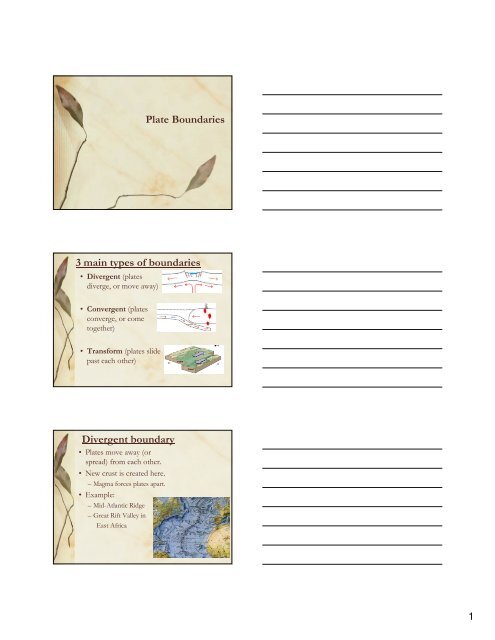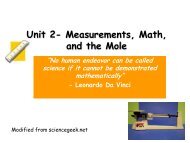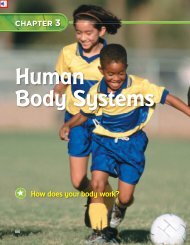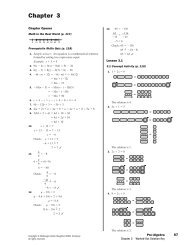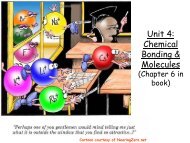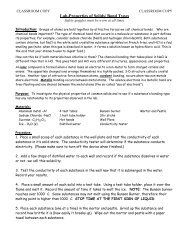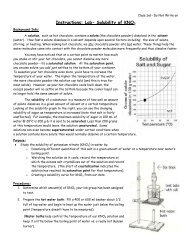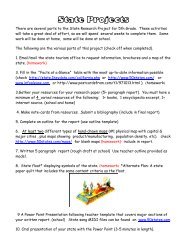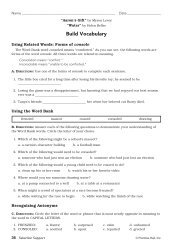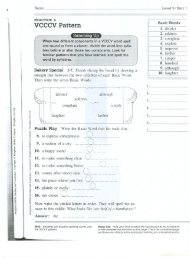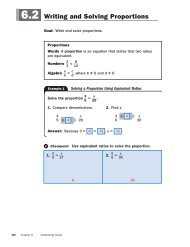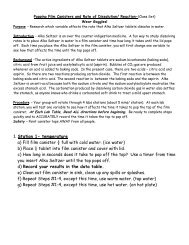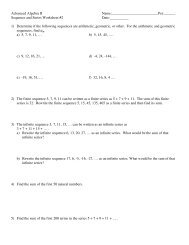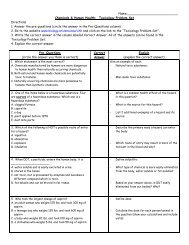Plate Boundaries 3 main types of boundaries Divergent boundary
Plate Boundaries 3 main types of boundaries Divergent boundary
Plate Boundaries 3 main types of boundaries Divergent boundary
Create successful ePaper yourself
Turn your PDF publications into a flip-book with our unique Google optimized e-Paper software.
<strong>Plate</strong> <strong>Boundaries</strong><br />
3 <strong>main</strong> <strong>types</strong> <strong>of</strong> <strong>boundaries</strong><br />
• <strong>Divergent</strong> (plates<br />
diverge, or move away)<br />
• Convergent (plates<br />
converge, or come<br />
together)<br />
• Transform (plates slide<br />
past each other)<br />
<strong>Divergent</strong> <strong>boundary</strong><br />
• <strong>Plate</strong>s move away (or<br />
spread) from each other.<br />
• New crust is created here.<br />
– Magma forces plates apart.<br />
• Example:<br />
– Mid-Atlantic Ridge<br />
– Great Rift Valley in<br />
East Africa<br />
1
Geologic phenomena at divergent <strong>boundaries</strong>:<br />
* = unique to divergent <strong>boundaries</strong><br />
– Iceland* (formed right on top <strong>of</strong> Mid-<br />
Atlantic Ridge)<br />
– Volcanoes<br />
– Earthquakes<br />
– Mountains<br />
• Fault-block mountains (one side is<br />
dropping lower as crust spreads)<br />
– Mid-Ocean Ridges*<br />
– Rift Valleys*<br />
– Spreading Zones*<br />
• Crust is spread out and stretched as plates<br />
move apart.<br />
Mid-Ocean Ridges<br />
• New crust created here.<br />
• See “Evidences <strong>of</strong> <strong>Plate</strong><br />
Tectonics” Notes for more<br />
detail.<br />
Rift valleys (divergent)<br />
•A deep valley formed by the two plates<br />
moving away from each other.<br />
•Crust warps downward, spreads, eventually<br />
“breaks” (<strong>boundary</strong> comes to surface)<br />
Example: Great Rift Valley in East Africa<br />
2
Convergent <strong>boundary</strong><br />
• <strong>Plate</strong>s move toward each other and<br />
collide.<br />
• Crust is destroyed here.<br />
• Subduction: Where one plate sinks<br />
underneath another and is forced<br />
into the mantle (then melted)<br />
Geologic phenomena at convergent<br />
<strong>boundaries</strong><br />
– Volcanoes<br />
– Earthquakes<br />
– Mountains<br />
• Folded mountains (crust<br />
crumples/folds upward)<br />
– Trenches/subduction<br />
zones*<br />
– Volcanic Island Arcs<br />
(ocean-ocean<br />
<strong>boundary</strong>)*<br />
Types <strong>of</strong> Convergent <strong>boundaries</strong><br />
Continent-Oceanic<br />
• Ocean plate collides<br />
with a continent.<br />
• Ocean plate sinks.<br />
• Forms a trench.<br />
– Trench: also called a<br />
subduction zone,<br />
where one plate<br />
subducts under the<br />
other.<br />
3
Continent-Oceanic, continued<br />
• Examples:<br />
– Juan de Fuca plate and<br />
North American plate<br />
• Juan de Fuca plate<br />
subducts under N.A. plate;<br />
created the Cascade<br />
Mountain Range in<br />
Northern CA, OR, and<br />
WA.<br />
• Nazca plate and South<br />
American plate<br />
– Subduction <strong>of</strong> Nazca<br />
plate formed Andes<br />
Mountains on west coast<br />
<strong>of</strong> S.A.<br />
Types <strong>of</strong> Convergent <strong>boundaries</strong>,<br />
continued<br />
Continent-Continent<br />
• Two continents<br />
colliding<br />
• Pushes the crust<br />
upward to form<br />
mountains.<br />
Continent-Continent Example<br />
• The Himalayas and<br />
Mount Everest—<br />
formed by Indian<br />
<strong>Plate</strong> and Eurasian<br />
<strong>Plate</strong>s colliding.<br />
4
Types <strong>of</strong> Convergent <strong>boundaries</strong>,<br />
continued<br />
Oceanic-oceanic<br />
• Two ocean plates collide.<br />
• The older one sinks under the newer one.<br />
• Creates volcanic island arc *Not<br />
Hawaii!*<br />
Oceanic-Oceanic examples<br />
– Mariana Islands<br />
(volcanic!): Formed by<br />
Philippine plate and<br />
Pacific plate<br />
– Tonga Trench in South<br />
Pacific (Pacific plate<br />
subducting under<br />
Australian plate)<br />
• Fastest moving plate: 24<br />
cm/year!!<br />
Transform <strong>boundary</strong><br />
• <strong>Plate</strong>s move past each other laterally.<br />
• Neither plate is destroyed.<br />
• Example:<br />
– San Andreas Fault (formed by North<br />
American and Pacific plates)<br />
5
Geologic phenomena associated with<br />
Transform <strong>Boundaries</strong>:<br />
• Earthquakes<br />
• Some warping <strong>of</strong> crust<br />
Why <strong>Plate</strong>s Move<br />
• Convection is the driving force behind plate<br />
movement!<br />
How It Works:<br />
1. Magma in the mantle is heated by the core.<br />
2. Heated magma rises toward crust.<br />
3. As magma moves away from heat source, it begins<br />
to cool.<br />
4. Cool magma sinks back down toward core, creating<br />
a convection cell that helps move crust.<br />
6


